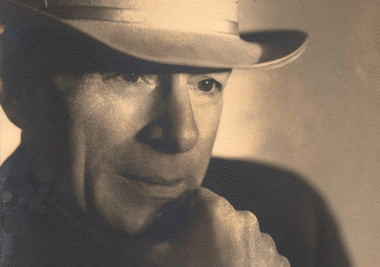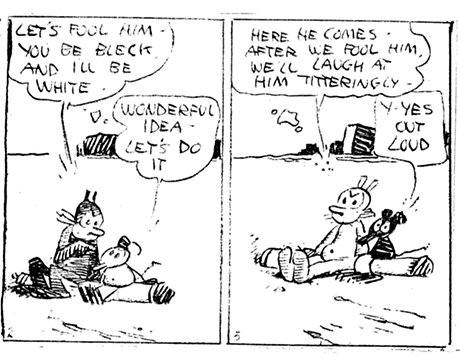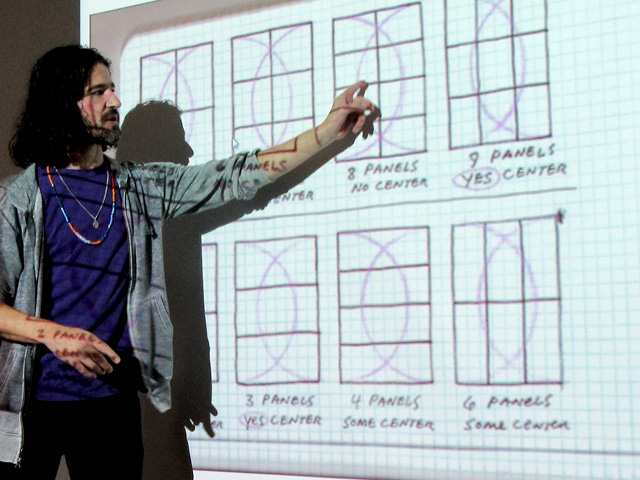We’re here today with Johnny Ryan escapades, Alexis Zirrit colors, George Herriman’s new biography, and notes on Box Brown via Adam Griffiths.
—————————————————————————————————
Sam Ombiri here:
For all those Johnny Ryan fans out there, there’s this fun podcast called Bone Zone hosted by Davey Johnson (sometimes), Randy Liedtke, and Brendon Walsh (https://www.youtube.com/watch?v=WmGAwNylqXA). It might get a little in jokey at times, so I don’t know how it sounds to a new listener.
My favorite part in this episode was when they were calling a bunch of comic book shops and asking people if they had a bunch of imaginary titles. They would, at times,add little details here and there, so that the titles sounded more plausible. They would ask while trying to hold back laughter so most people couldn’t tell something was up, and there was a slight distortion in reality. They were greeted with skepticism – but then they’d add a small detail like “I think it was published by Oni press”, and then people who were familiar with Oni Press were suddenly way less skeptical. “We just got a bunch of Oni Press last week,” you’d hear the shopkeepers in the background yelling. “Yeah they’re asking for all these obscure titles – do we have Money Boys? or what was that other one? Cum Tuba?” To which Johnny would add, “Yeah, Cum Tuba by Chris Ware.” Then out of all this nonsense, this story about 3 brothers looking for comics, from a list that their sick dad had given them, constructs itself. At one point like 10 wild dogs begin chewing their sick dad’s comics.
Some of these comics sound like a bunch of fun to draw – I’m really into drawing a comic called Money Boys, just basing off the multiple premises that come to mind when I hear the name. This episode of Bone Zone was also a good reminder of how I still need to read Prison Pit. There’s a lot of stuff that I always need to get to, but then I don’t. I like this thing that Brandon Graham (I think it was him) said – how, in comics, there’s just constantly great stuff being created, and that no one has all the time to read it all. He makes sure to note how you’d think he’d find it depressing, but it’s just the opposite for him. There’s always this thing of, when you discover something that possibly will be really rad, you want to preserve the little mystery of it. (Like how my listening to Chll Pll has been a nearly 2 year process, from it being recommended by a friend, to me listening to it slowly.) Maybe it’s a result of the immediacy of information in the internet, and “knowing” isn’t everything. Gary Panter said in this one talk that how physical mediums are fetishistic. I think that’s a good way of describing it, although I need to find a better word than “fetish” to describe things these days, just because of its modern definition – it only fits in the one context so then it’s forced to be used as a metaphor. This might not be a bad thing, especially for someone like Refn.
I don’t know how to say this, but I’m reminded of how at the Oscars (which feel like a huge joke these days) when they present the animation awards, they use the extremely shallow depiction of animation – that you can “draw anything” and make anything happen, unlike in live action movies. It’s such awful thing to say. – Sam Ombiri

—————————————————————————————————
Tyler Landry here, and it’s time to talk about Alexis Ziritt.
Dude is a machine. Open up Space Riders at any page and feel your mind explode. BOOM! This is a serious action trip with all the trimmings, but what I want to focus on specifically is the colors.
Flipping through my copy of Space Riders, a couple of things strike me, color-wise. First, this comic is vibrant. Every color that’s ever been imagined is in here somewhere. It’s fearless. The next thing that hits me is the way in which the colors CHANGE from page to page, spread to spread. Alexis uses different combos of straight palettes – where a suit is its own color, the flesh is its own color, the landscape is its own color, etc. But these are mixed with really intense moody scenes with light cast from viewscreens, explosions, or atmosphere. This is where the work really shines, in my opinion. Regardless of the approach, straight or moody, there’s great attention to how those colors help to move you through the work.
Let’s look at some of this deep, moody shit:
Both of these pages make extensive use of color as mood, and as focus.
In the top image, the ship has taken damage, as has the morale of its crew – perfectly communicated with everything bathed in RED emergency lightning, punctuated with shots of YELLOW sparks. The crew members are only a slightly lightened version of that color, barely elevating them from their background. This helps bake the gravity of their situation into your brain as you read through the page. Then, as the discussion heats up, we’re treated to hints of GREEN glow from the viewer, exploding into a bigger viewscreen shot of a pile of angry aliens right outside – in GREEN. This color play from RED to GREEN = direct contrast, jarring change, intense move.
On the bottom, again, an overall mood is set in hot PINK, but this one has a constant cool BLUE undertone, shown in the characters themselves, selectively. This creates a triangular slide, down which your eyes move, towards the edges…and it slams itself wide open in the YELLOW panel, where the characters heat up, and one darts across the page to meet the other in a devastating headbutt. Then, the scene pulls out and settles again, with nearly everything melting into the haunting PINK background – except for Capitan Peligro, cold and bold in BLUE, delivering a one-liner as tough as his nose-crushing blow in the previous panel. And – let’s not forget the burst and trickle of GREEN, reminding us just how significant this wound really is. – Tyler Landry
Get a copy of Space Riders from Copacetic Comics – HERE.
—————————————————————————————————

Sally here – The eagerly anticipated Krazy: George Herriman, A Life in Black and White by Michael Tisserand was released on Tuesday, Dec. 6th. Both the cartoonist and the biographer are originally from New Orleans, and a passing interest in George Herriman turned into a 10 year research project for Michael Tisserand after Hurricane Katrina nearly destroyed their city.
” “I had to teach myself to be an historian,” Tisserand said. “I didn’t anticipate the amount of difficulty it would be finding Herriman’s work.”
Like a snake handler, Tisserand uncoils the confusing racial politics of New Orleans in the Jim Crow era, where the descendants of slaves and the descendants of so-called free people of color suffered segregation, discrimination and violence at the hands of the white population.
As Tisserand explains, when Herriman was 10 years old, his parents fled the South for a new beginning in California, where personal reinvention was possible. As Tisserand wrote, “Herriman was a black man born in New Orleans.” But upon reaching the Pacific, Herriman’s parents “had obscured their identity and ‘passed’ for white.”
Had they not done so, Tisserand points out, the creator of the immeasurably influential Krazy Kat cartoon could never have received the classical education that he did, found work in major American newspapers, or bought a home in the Hollywood Hills, owing to universal racism.” – via NOLA.com

Read the rest of the above article about the book HERE. There’s another good piece in Gambit, HERE. And The Wall Street Journal names Krazy Kat the “most ingenious strip of the 20th century“. In addition, there is a great “Konversation” with Michael Tisserand over on The Comics Journal – check it out HERE.
—————————————————————————————————
Adam Griffiths interviewed Box Brown recently for his ‘Zine Tree” series. They talk about Brown’s work (his newest book is Tetris: The Games People Play) and how he chooses his stories.
AG: Three works of yours, Andre the Giant, Powerman, and Tetris, all seem to grapple with the theme of unconventionality, aspiration and conformity? If you agree with that to any such degree, how would you say you choose the stories that you tell?
BB: I think that’s been my life experience.
I identified with Andre as the person that had to operate on the outskirts of life. I think he felt like he was an outsider. I think for the early part of my life I felt that way a lot. Of course in high school but then I kind of still suffered from identity issues into my 20’s. It wasn’t until I discovered making comics that I discovered who I was. Until then I never felt like I fit in, but outwardly strangely I had figured out how to fit in. It just always felt like an odd fit.
Read the rest of the interview HERE.

Adam Griffiths is a cartoonist from the D.C. area who will be joining us at the Rowhouse in Pittsburgh for a Residency early next year. Be sure to check out more of his work HERE.
—————————————————————————————————
Email santoroschoolATgmail for more details!
—————————————————————————————————
Suzy and Cecil – 12-8-2016 – by Sally Ingraham




